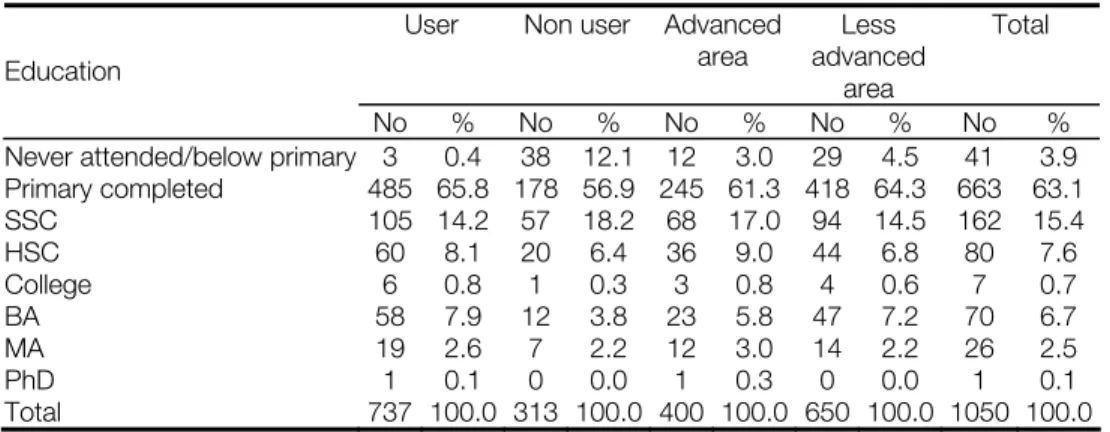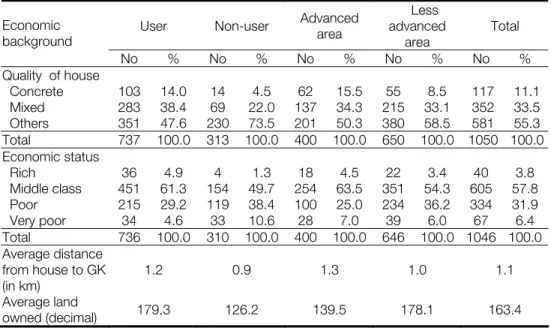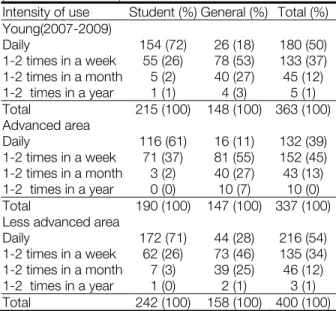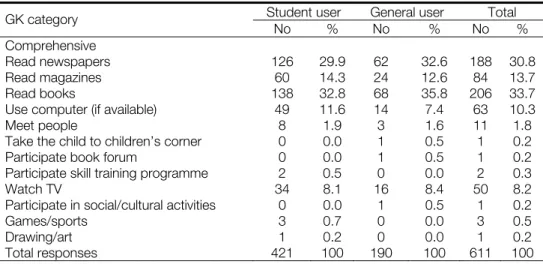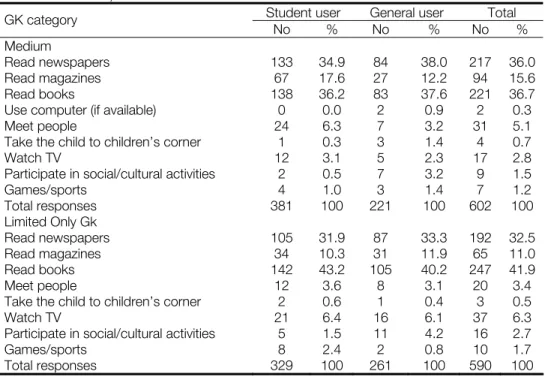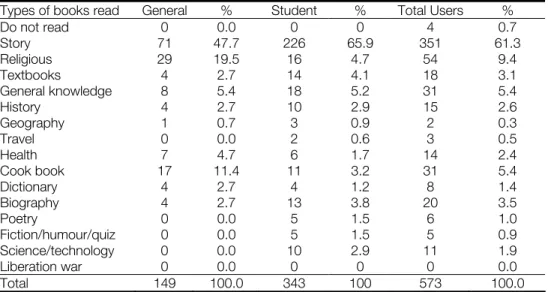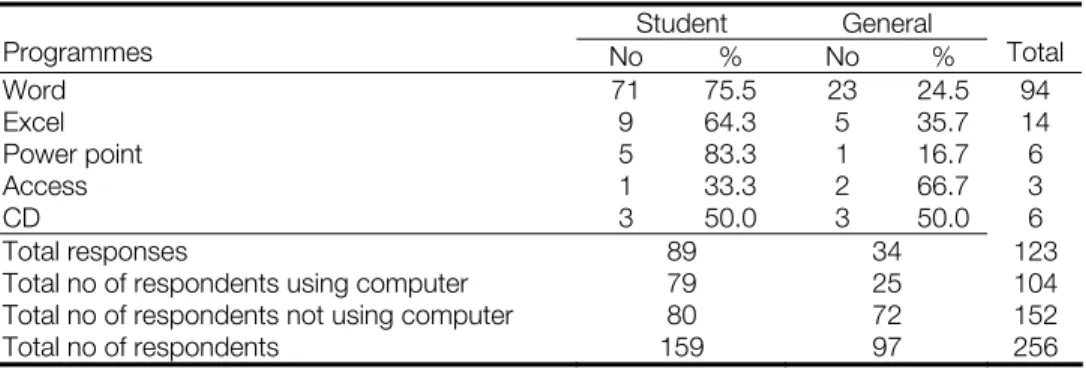Results on process evaluation show that among the 900 respondents from GK areas were the users of library. Local leaders also confirmed that the impact of library was very positive for women's empowerment.
Section 1
INTRODUCTION, AIMS AND OBJECTIVES OF THE STUDY
- Multi-purpose community learning centres in rural Bangladesh and overall aim of the study
- Background information on Gonokendro (this section is based on information provided by BEP, BRAC)
- Major goals of the study
- Section 2
- Description of methods
- Study design – selection of study areas
- Selection of respondents
- Instruments of data collection Survey
Gender equality target: It is ensured that 50% of the members are female from the start. Methods used in this study were determined by the nature of the questions raised.
PROCESS EVALUATION (BASED ON SURVEY AND IN- DEPTTH INTERVIEWS WITH LIBRARIANS)
Section 3
DESCRIPTION OF STUDY AREA AND RESPONDENTS
Description of GK and control areas
List of selected GKs and control sites
- Description of respondents
- Socioeconomic background of user and non-user respondents in different locations
This is partly because most of the users were high school students and had just finished elementary school. Consequently, the proportion of males who have a higher level of education is greater than that of females, especially beyond the SSC level (Table 3.3a).
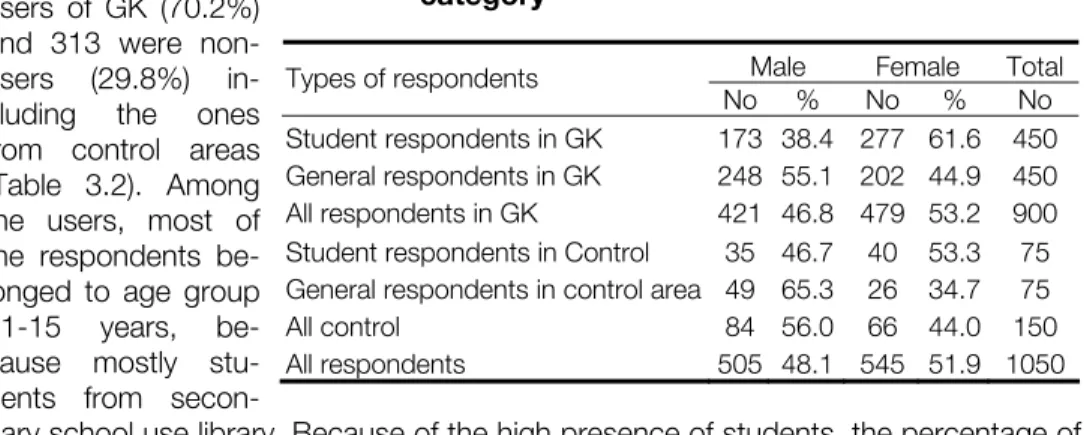
Section 4
PATTERN OF USE OF LIBRARY
- Pattern of use by type of users in different GKs
- Frequency of use
- Facilities and services mostly used
- Use of computer programmes
- Factors determining the probability of being a member or user
- Factors affecting the probability of being a member of GK
- Factors affecting the probability of being a user of GK
- Section 5
The decision to become a member and user of GK will depend on several factors – the type of GK in terms of facilities, the age or maturity of the GK and its location, and the person's personal characteristics in context such as education, age, family background. Almost all variables (except GK is old) entered into the model are found to be significant at 1% level (Table 4.12).
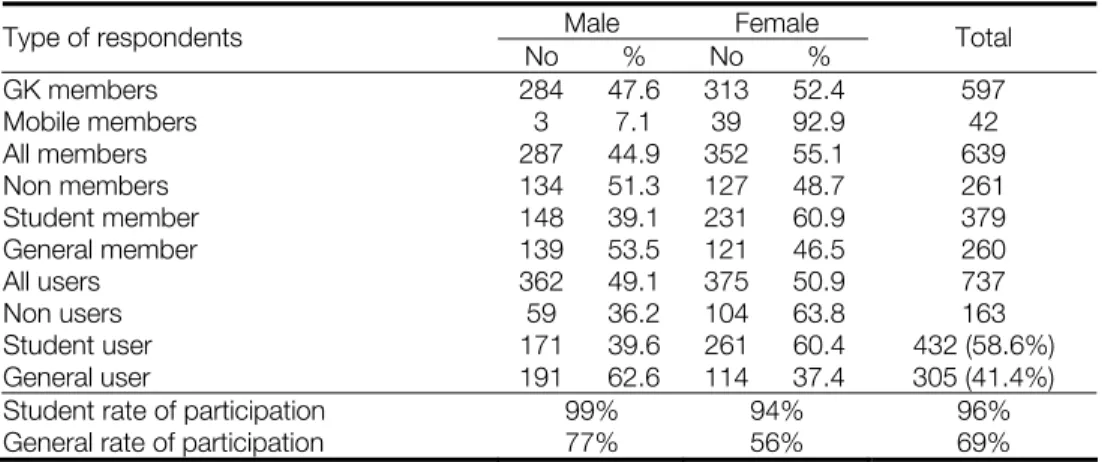
USER SATISFACTION AND SUGGESTIONS FOR IMPROVEMENT
Satisfaction with library services
In Section 4, we discussed the usage pattern of the facilities and found that reading books and newspapers was the most common activity among users. It shows that the ability to read and the availability of books and magazines were the most preferred aspects in all GCs by type, maturity and location. Some mentioned the lack of availability of desired books, TV, musical instruments and sporting goods.
The pattern of dissatisfaction with various aspects of GK did not differ significantly between GK categories and user types. However, the number of students complaining about the availability of books and other facilities was higher in facilities-restricted PGs compared to other PGs.
Suggestions of users for improvement of GK services
Good management and pleasant atmosphere of CGs was also mentioned by a number of respondents, about 14-15% of the total responses, except for CGs of medium facilities. A number of respondents complained about the library's bad atmosphere, particularly the high noise level, inadequate seating, lack of electricity and security features.
Section 6
OWNERSHIP, GOVERNANCE, MANAGEMENT AND SUSTAINABILITY ISSUES
Section 7
UTILIZATION OF MOBILE LIBRARY
Survey data
Members of mobile library saw it as an advantage to have the books delivered at home. Like the GK members, a large majority of mobile members (73%) wanted to prevent such an event. Our data show that in GKs without a mobile library, the participation of women was higher.
In addition, various types of services were offered in the GK which were not possible in the mobile library. Since the mobile library meets the needs of the elderly and people with disabilities that GCs cannot meet, it is important to keep them.
Section 8
OPINIONS OF NON-USERS FROM GK AND RESPONDENTS FROM CONTROL AREA
We only asked a separate question to respondents from control areas regarding their perception of the benefits of a library. Around 80% of the responses were related to education: opportunities for reading and learning, promotion of knowledge/talent and homework help for children. Expected benefits Frequency Percentage More opportunities for reading and learning 163 54.2 Can help children with their homework 56 18.6.
Given the high interest among the general population, even among the poor (we noted in FGDs) and in control areas, there is an urgent need for expansion of the program. FGDs in control areas show that women had no place to meet other people, children need books, lack of youth activities and newspapers were not available.
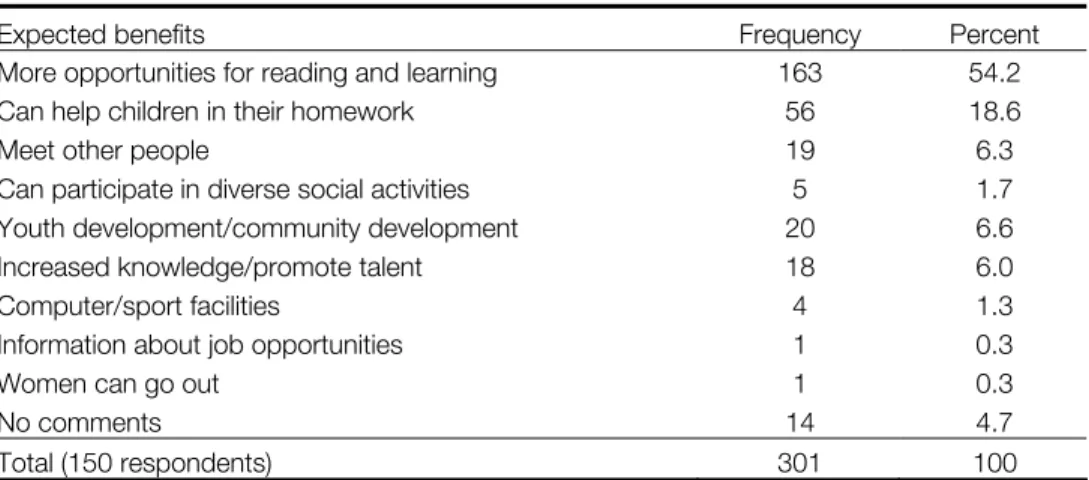
Section 9
- Reading habits of respondents and links with GK
- Role of library in social awareness and information acquisition
However, the results show that the percentage of respondents who answered all questions correctly was 52% in GK areas and 25% in control areas. In control areas, societal benefits weighed more heavily than individual benefits compared to GK areas, where more responses came for personal benefits. We hypothesize that this difference is due to actual/personal experience of improved reading ability in GK areas.
There was a small difference between GK areas and control areas – 39% in GK area participated regularly while in control area it was 37%. In control areas, 76% of respondents were interested in news about Bangladesh and the corresponding number for GK areas was 94%.

Section 10
BENEFITS OF GK IN ACQUISITION OF KNOWLEDGE, AND CHILD DEVELOPMENT
Knowledge acquisition
On the other hand, in control areas more parents (74%) regularly helped children with homework, compared to that in GK areas (67%). The proportion of "don't help" was also much higher in GK areas than in control areas. Most parents in the control areas helped their children go to school, but not with household chores.
Moreover, in control areas, parental support in school-related matters mainly concerned preparation for going to school. Such interest in reading skills due to the children's corner suggests spillover effects of GK intervention.
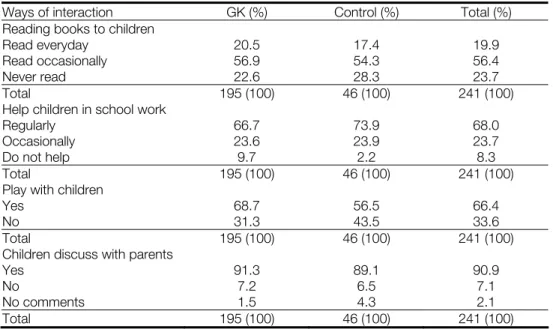
Section 11
BENEFITS IN FAMILY LIFE AND EMPOWERMENT OF WOMEN
- Family relationship
- Empowerment of women
- Community perception about role of GK/library in empowerment of women
- Section 12
The responses indicated that in GK areas, respondents spoke from their experience, while in control areas it was theoretical assumption. Awareness of own rights 32 34 Social interaction and activities/voice/free mobility/marketing 34 24 Women's opinions become important 22 22 Women get education/skills/ability to express their own opinion 39 50 Gender equality in case of employment 3 8 Job opportunities Empowerment of It is expected that women will be reflected in their activities outside the home as a result of their visit to GK. Our results show that a small percentage of women did not participate in outdoor activities in both GK and control areas.
In the control areas, participation was more in income-earning activities, while in the GK areas, marketing and participation in social activities were more important compared to the control area. It can be concluded that women in CG areas tended to go out more and for a variety of activities compared to women in the control area, although the differences were not very wide.

- Benefits from parents being a member of GK or library
- Interaction of parents with children in GK and control areas
- Role of GK/library in promoting talent
- General knowledge test 22
- Factors affecting scores in general knowledge test among students of class VI-class IX
- Section 13
In response to the question whether fulfilling their ambitions without a library was possible or not, 59% answered "yes" (Table 12.3). Other sources of help besides the CG or library as mentioned were parents/other relatives, teachers, other educational institutions, coaching and their own efforts (Table 12.4). We hypothesized that using the services provided by the GC, especially the reading opportunities, could improve students' overall knowledge.
The percentages with 4 and 5 correct answers were 82 in the GK area and 35 in the control (derived from the figures in Table 12.5). We applied an OLS regression model to find significant factors associated with general knowledge.

INFORMATION FROM LIBRARIANS
- Personal background of librarians
- Information on GKs
- Pattern of utilisation of library
- Steps to be taken to fulfil the objectives of the programme Table 13.7 Opinions of librarians about the steps
- Personal experience of librarians
- Section 14
When asked about trends in the use of GK, all librarians indicated an increasing trend, mainly due to the public's interest in reading books and newspapers, as well as the computer/TV (table 13.4). For librarian data, a more even distribution among programs was found, with Excel, graphics, and CDs gaining in importance (Table 13.6). Of the 51 responses, the main ones were increased number of members (23.5%), regular publication of books (21.6%), computer/TV/micro museums and increased reading habits among users (Table 13.8).
About 32% of the responses were for librarians themselves such as more training for librarians, extra personal benefits in relation to their children and opportunity to run a small shop (Table 13.9). The highest number was for empowerment of women, followed by impact on youth, participation in social activities and in creative work Table 13.11).

SUMMARY, CONCLUSIONS AND POLICY RECOMMENDATIONS
Summary of findings Process evaluation
We ran two probit regressions to find out which factors influence the probability of being a member or user of GK. The most important factors behind the probability of being a member of GK are age of respondent with a negative sign, other library members in the family, type of GK, socio-economic status of respondent, and being female in intervention area is likely to have a positive influence . We could see no consistent pattern in the intensity of utilization by GK types.
A significant difference between control and GK areas, especially for females in reading habits, was observed. The pattern of interaction with children: a slight difference was observed with positive results in GK area.
Conclusions
Second, while the share of women in total users was 51% because they included two girls' schools in our sample, 37% were women among general users. It appears from our data that the gender part of the second outcome goal of having 50% female users has been met. With such a small sample, it is difficult to say whether the third outcome objective of BRAC related to livelihood skills training was fulfilled or not.
It appears from our survey data and FGDs that the fourth outcome objective related to ownership has been largely met, as reflected in the eagerness and enthusiasm of local people to patronize the institution. This is reflected in the felt needs of people, their behaviour, lifestyle and frustration.
Recommendations for policy and research
If this is the case, what should be BRAC's policy regarding expansion versus upgradation of existing centres. Some impacts are easily discernible and can be attributed to library visits, for example, when women visit the library regularly, it helps them interact with the outside world and increases their self-confidence. Similar is the case with the impact on children as a result of parents' increased reading habits, mothers' exposure to the outside world, etc.
Towards a plurality of methods in project evaluation: A contextual approach to understanding trajectories of impact and effectiveness. Beyond Assessment: Assessing the Impact of Community Education Development in the LAO PDR, Review of Education Measurement and Evaluation, Vol.
APPENDIX
Education status of the population: 40% can read and write, 90-95% can draw with the help of their children. Because of the Children's Corner, many women go to the library with their children, even if they cannot read and write. Use of the library: Many general public visitors as it is near Upazila's office but more.
Running the organization needs skilled people and should be strengthened by a young man. The person whose grandfather once donated the land for the school is trying to dominate the discussion about possible improvements to the school. The director of the school reports that the SSC exam results are good and that the lack of high performance is due to the socio-economic background of children, who come from very poor families with parents who have no education.
1= US presidential election; 2= Malala incident/news in the subcontinent; 3= Middle East News; 4= health related/new ideas/invention; 5= Rohinga issues; 6= the film about Islam/Muhammad; 7= sports; 8= employment abroad; 9= global news/end of the universe on 12.12.21 /Sandy/Tsunami/ of course.

